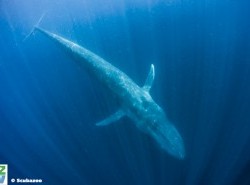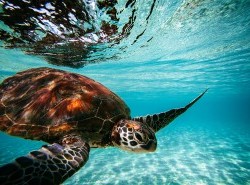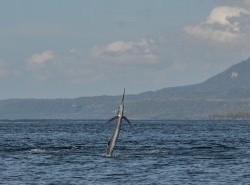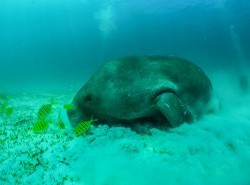There is a yellow tennis ball at the end of the plumb line, but it is lost in the murk beneath me. It’s just 20 metres away but its invisibility makes it feel further. 20 metres is the maximum depth on this beginner free dive course that I’ve signed up for in Bali, Indonesia. Our instructor has told me I’m ready to try the depth at Constant Weight – the free diving discipline where you propel yourself down and up using fins or increasingly nowadays, a monofin. But I"m not happy.
The stillness of free immersion - you can see here its meditative aspect
The weather has changed and with it my mood. I feel apprehensive and my heart rate increases. Looking down through my low volume mask – streamlined to reduce drag – I find myself reluctant to head down. My instructor checks if I’m ready. I nod, take in three breaths and do my best to execute a smooth duck dive. Pride takes me to within a metre of the tennis ball, but my lungs are bursting and I have to turn back, trying to stay calm as my body protests the lack of oxygen.
20 minutes before I had completed a two-minute Free Immersion dive, eyes closed, pulling myself along the rope hand over hand down to the tennis ball and returning the same way. Throughout, I had felt a sense of calm and space, bordering on bliss. What was the difference between the first dive and the second? Mainly my state of mind. Welcome to free diving.
The tiny coastal community of Amed in North Bali is a dream location to learn to free dive - a narrow strip of dive shops, cafes, restaurants and small scale resorts that are a welcome respite from the island’s overdeveloped south. The setting is dramatic: arid foothills rise steeply behind the village and on clear days you can see the peak of Gunung Agung, Bali’s sacred volcano, just a few miles inland. Beaches of black sand and pebble give onto the turquoise waters and the coral reefs that have made this something of a dive Mecca.
The author free diving in Raja Ampat, with little idea of safety or technique.
Kwabena Edusei (Kwab) & Matthew Smyth set up Apneista Free Diving & Yoga here back in 2010 – the first school of its kind in Bali. It’s now something of an institution in Amed, as popular for laid back beachfront lunches as it is for its Apneista & Scuba School International (SSI) certified courses. Kwab, a softly spoken Englishman, looked after our group. The first half day of the two-day beginner’s course is spent on theory – dive safety (always free-dive with a buddy, as with scuba) buoyancy, breath and swim technique. But there is something else too.
Apnesita's free diving trip to Raja Ampat
When we free dive, an ancient biological process kicks in. It’s called the Mammalian Dive Reflex (MMR) and it is the legacy of our aquatic ancestors. All mammals have it to a greater or lesser degree. When we submerge even just our faces in cold water, or go to greater depths, our heart rate immediately begins to slow and through peripheral vasoconstriction (the narrowing of blood vessels) our blood shifts from our extremities into the life support system of lungs, heart and brain. MMR also activates our parasympathetic nervous system – hence that feeling of deep calm.
Free diving is a great way to explore underwater environments without lots of bulky noisy gear
The connection between free diving and practices like yoga and meditation isn’t accidental. All three apply techniques aimed at mastering the mind. They focus on breath and on calm, concentrated awareness. “If you get agitated underwater, your heart rate increases and your body is robbed of much needed oxygen,” Kwab explains. A keen surfer and practitioner of Vipassana meditation and yoga himself, he comes across as fairly unflappable. “That’s something you can’t afford at depth.”
There’s no denying that free diving is dangerous – but few fatalities occur at depth. The big killer is shallow water blackout – or more accurately, hypoxic blackout, where the body doesn’t have enough oxygen to maintain consciousness. And it doesn’t necessarily matter how deep you’re diving.
Apneista free divers during a trip to Raja Ampat in far eastern Indonesia
“What you absolutely don’t want to do is hyperventilate,” says Kwab. This is when free-divers over-breath, rather than loading extra oxygen, this causes carbon dioxide levels in the bloodstream to drop. Counter intuitively, Co2 is needed for the body to metabolise oxygen – hyperventilation delays the urge to breathe and dramatically increases the chance of hypoxia and blackout.
Note the snorkel in the mouth - a big no-no in free diving.
According to Kwab, hyperventilation does not improve performance anyway. “Besides the danger, it doesn’t actually give you any more oxygen – but it will delay the MDR and all of the benefits it has for the freediver,” he explains. There's no denying that free diving places the body in an extreme environment - especially when you go to more extreme depths. But whether you’re drawn to the deep, or the chance to get up close and personal with colourful reefs and marine life – free diving is a profoundly satisfying experience when done safely. And
Freedom
For many, including me, it is a natural progression from snorkelling. In Raja Ampat – the global epicentre of marine biodiversity in the heart of the Coral Triangle – I discovered the joys of taking a breath and hanging out at 10 or 15 metres facing resplendent coral walls or swimming through swarms of schooling jacks. Unhampered by gas tanks and BCDs and the constant low rumble of bubbles, you feel much closer to the life around you.
It’s the final afternoon session and I’m keen to recapture that blissful feeling on a Constant Weight dive. I’ve been instructed how to fin down – removing my snorkel first (it mitigates the risk of flooding the lungs in the event of black out) and kicking smoothly and uniformly, keeping my legs as straight as possible.
students wait at the buoy for their turn to descend the plumb line
Though I keep my eyes open, I manage to access a state of deep mental relaxation – my gaze wide, not looking for the tennis ball, just moving downward one stroke at a time. I’m surprised at how quickly my hand reaches the end of the line. I take my time flipping up the other way and fin steadily upward, arms describing an arc over my head and then in front of my body to maximise propulsion.
Scuba diving can sometimes make me feel claustrophobic, but as I gradually approach the surface, I feel embraced by the water around me. And in that moment, I feel…free.
Apneista run 2 day to multi week courses from Beginner up to Instructor Level. Find more information about upcoming courses on their website










